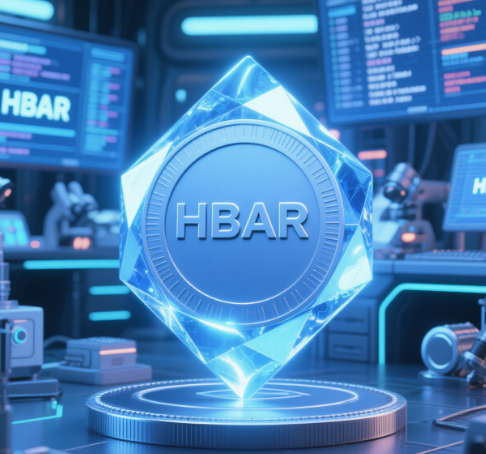HBAR is the native cryptocurrency of the Hedera Hashgraph network, a decentralized public ledger that goes beyond traditional blockchain technology
HBAR is the native cryptocurrency of the Hedera Hashgraph network, a decentralized public ledger that goes beyond traditional blockchain technology. Unlike standard blockchains such as Bitcoin or Ethereum, Hedera uses a different consensus mechanism called the hashgraph algorithm. This algorithm allows for significantly higher throughput, fast finality, and strong security—all while maintaining low transaction fees.
HBAR serves two primary functions on the Hedera network:
Fuel for Transactions and Smart Contracts – HBAR is used to pay for computational services on the network, including transferring HBAR tokens, running smart contracts, and storing files.
Network Protection via Staking – HBAR holders can stake their tokens to nodes on the network, helping to secure the consensus process and earn rewards.
The network’s efficiency and energy-conscious approach make HBAR stand out in a crowded cryptocurrency market.
HBAR’s Unique Advantages Over Traditional Blockchains
While many cryptocurrencies aim to offer decentralized services, HBAR brings a unique value proposition. Here’s how it differentiates itself:
1. Speed and Scalability
Hedera claims to handle over 10,000 transactions per second (TPS) with finality in 3-5 seconds. In contrast, Bitcoin processes around 7 TPS and Ethereum 15–30 TPS. This makes HBAR suitable for high-volume applications like gaming, supply chain logistics, and enterprise-grade solutions.
2. Energy Efficiency
HBAR is one of the most environmentally sustainable cryptocurrencies on the market. Hedera’s consensus mechanism requires far less energy than Proof-of-Work (PoW) networks. According to the UCL Centre for Blockchain Technologies, Hedera consumes 0.00017 kWh per transaction, compared to 707 kWh for Bitcoin.
3. Enterprise Adoption
HBAR has seen significant adoption from corporate giants. Hedera's Governing Council includes major firms like Google, IBM, Boeing, LG, Standard Bank, and more. These members run validator nodes and help govern the network, adding a layer of credibility and long-term stability.
4. Fixed Supply and Predictable Tokenomics
HBAR has a fixed maximum supply of 50 billion tokens, ensuring no inflationary pressure over time. About half of the supply is already in circulation, with the remainder to be released gradually via staking rewards, ecosystem development, and partnerships.

Real-World Use Cases Driving HBAR Adoption
HBAR isn’t just a speculative asset—it powers real-world applications across various sectors:
Supply Chain: Companies use Hedera for tamper-proof logging of goods through logistics chains.
Healthcare: Solutions like Safe Health Systems are using Hedera to manage health records securely.
NFTs and Gaming: HBAR supports high-speed minting and low-fee transactions, ideal for game developers and digital artists.
Carbon Credits: Projects like DOVU and Tymlez use Hedera for tracking and verifying carbon offsets transparently.
Such diverse use cases position HBAR as more than just a token—it’s an infrastructure-level asset.
Price Performance and Market Sentiment
Despite the 2022–2023 bear market, HBAR has shown resilience. At the time of writing, HBAR trades in the $0.08–$0.12 range, with a market cap consistently ranking in the top 50 by CoinMarketCap. Analysts and crypto enthusiasts often highlight HBAR as undervalued relative to its technology and partnerships.
Investor sentiment toward HBAR is increasingly bullish, especially as awareness of Hedera's enterprise-friendly model and eco-friendly credentials spreads. The growth of staking platforms and DeFi integrations has further added momentum.
The Future of HBAR: A Long-Term Contender?
HBAR’s long-term success hinges on continued network development, ecosystem expansion, and user adoption. The Hedera team has been actively rolling out updates, including support for native staking, improved smart contract functionality (via the EVM-compatible Hedera Smart Contract Service), and interoperability with other blockchains.
As ESG (Environmental, Social, Governance) concerns rise among institutional investors, HBAR’s low energy usage and transparency could become major drivers of adoption.
Moreover, with growing interest in tokenization, CBDCs, and decentralized identity solutions, HBAR is well-positioned to serve as the underlying infrastructure for a new wave of Web3 innovations.
Final Thoughts: Should You Pay Attention to HBAR?
Whether you're a developer, enterprise, or investor, HBAR deserves close attention. It offers a highly scalable, secure, and eco-friendly alternative to traditional blockchain platforms. With strong corporate backing and practical real-world use cases, HBAR is more than just a cryptocurrency—it's a cornerstone of a future digital economy.
As the market matures, projects with tangible utility and strong fundamentals—like HBAR—are likely to thrive. For up-to-date insights on HBAR, new partnerships, and market movements, stay tuned to Coin78, your trusted source for crypto exchange news and trends.
Stay ahead in crypto—stay informed with Coin78.
1. The information content does not constitute investment advice, investors should make independent decisions and bear their own risks
2. The copyright of this article belongs to the original author, and only represents the author's personal views, not the views or positions of Coin78. This article comes from news media and does not represent the views and positions of this website.
 USD
USD CNY
CNY HKD
HKD TWD
TWD VND
VND USDT
USDT